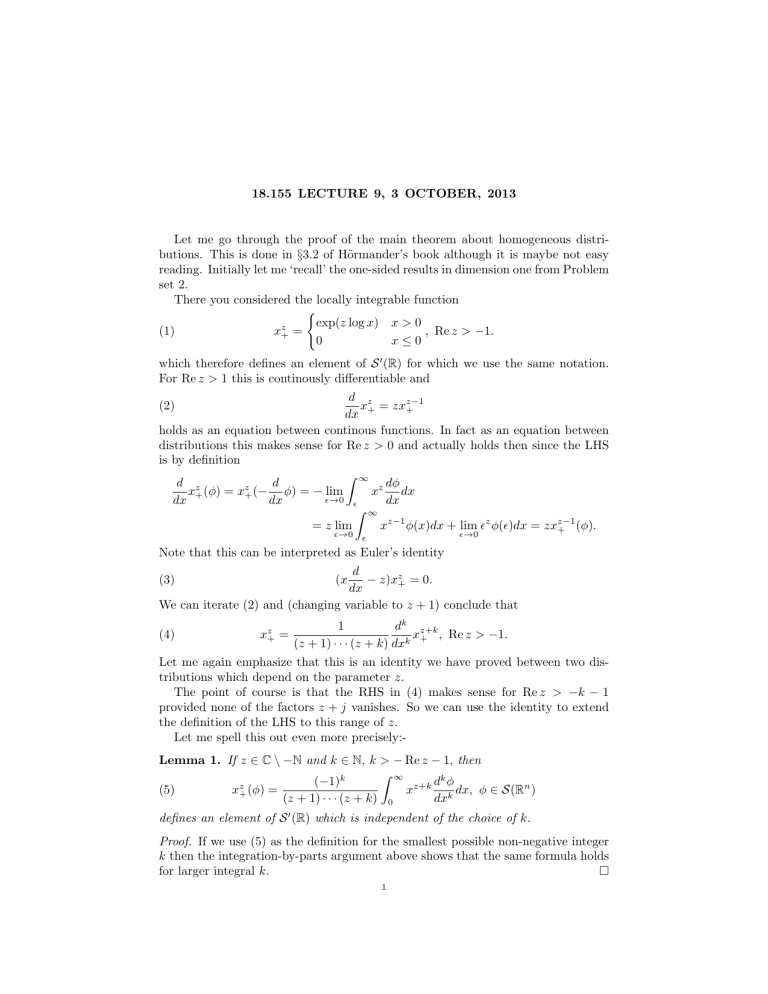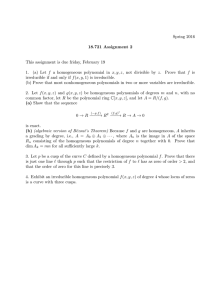18.155 LECTURE 9, 3 OCTOBER, 2013
advertisement

18.155 LECTURE 9, 3 OCTOBER, 2013
Let me go through the proof of the main theorem about homogeneous distributions. This is done in §3.2 of Hörmander’s book although it is maybe not easy
reading. Initially let me ‘recall’ the one-sided results in dimension one from Problem
set 2.
There you considered the locally integrable function
(
exp(z log x) x > 0
z
(1)
x+ =
, Re z > −1.
0
x≤0
which therefore defines an element of S 0 (R) for which we use the same notation.
For Re z > 1 this is continously differentiable and
d z
x = zxz−1
(2)
+
dx +
holds as an equation between continous functions. In fact as an equation between
distributions this makes sense for Re z > 0 and actually holds then since the LHS
is by definition
Z ∞
d z
d
dφ
x+ (φ) = xz+ (− φ) = − lim
xz dx
→0 dx
dx
dx
Z ∞
= z lim
xz−1 φ(x)dx + lim z φ()dx = zxz−1
+ (φ).
→0
→0
Note that this can be interpreted as Euler’s identity
d
− z)xz+ = 0.
(3)
(x
dx
We can iterate (2) and (changing variable to z + 1) conclude that
(4)
xz+ =
dk z+k
1
, Re z > −1.
x
(z + 1) · · · (z + k) dxk +
Let me again emphasize that this is an identity we have proved between two distributions which depend on the parameter z.
The point of course is that the RHS in (4) makes sense for Re z > −k − 1
provided none of the factors z + j vanishes. So we can use the identity to extend
the definition of the LHS to this range of z.
Let me spell this out even more precisely:Lemma 1. If z ∈ C \ −N and k ∈ N, k > − Re z − 1, then
Z ∞
dk φ
(−1)k
z
xz+k k dx, φ ∈ S(Rn )
(5)
x+ (φ) =
(z + 1) · · · (z + k) 0
dx
defines an element of S 0 (R) which is independent of the choice of k.
Proof. If we use (5) as the definition for the smallest possible non-negative integer
k then the integration-by-parts argument above shows that the same formula holds
for larger integral k.
1
2
18.155 LECTURE 9, 3 OCTOBER, 2013
If z is near −j, j ∈ N, and we look at (5) for some fixed k ≥ j then the limit
(6)
lim (z + j)xz+ (φ) =
z→−j
Z ∞
(−1)k
dk φ
lim
xz+k k dx
z→−j (z + 1) · · · (z + j − 1)(z + j + 1) · · · (z + k) 0
dx
exists and again defines a distribution. What distribution is it? The RHS converges
to
Z ∞
dk φ
(−1)k
xk−j k dx.
(1 − j) · · · (−1)(1) · · · (k − j) 0
dx
We can take k = j since we know the result is independent of k ≥ j and then
integration by parts gives
(7)
lim (z + j)xz+ (φ) =
z→−j
1
dj−1 φ
(−1)j−1 dj−1 δ
=
(
)(φ).
(j − 1)! dxj−1
(j − 1)! dxj−1
From this we can take two things. First, the limit of (z + j)xz+ as z → −j
in S 0 (R) (in the weak topology) is
Suppose φ ∈ S(R) satisfies
(−1)j−1 dj−1
(j−1)! dxj−1 δ.
We can also go a little further.
dj−1 φ
(0) = 0.
dxj−1
(8)
Then
lim xz+ (φ) exists.
(9)
z→−j
Certainly the limit in (7) vanishes as it should. In fact taking k = j in (5)
Z ∞
(−1)j
dj φ
xz+ (φ) =
lim
xz+j J dx.
(z + 1) · · · (z + j) →0 dx
In the inner limit if we perform integration by parts then the boundary term vanishes in the limit because of (8) and the resulting integral makes sense:
Z ∞
1
dj−1 φ
z
(10)
lim x+ (φ) =
x−1 j−1 dx
z→−j
(j − 1)! 0
dx
because the integrand is actually smooth down to 0.
As I explained last time we can use this to construct homogenous distributions
on Rn . If f ∈ C ∞ (Rn \ {0}) is homogeneous of degree z and Re z > −n then it
defines a locally integrable function on Rn and a tempered distibution:
Z
Z ∞
Z
(11)
f (φ) = |x|z f (x̂)φ(x)dx =
rz+n−1
f (ω)φ(rω)dωdr.
Sn−1
0
n
Here I have introduced ‘polar coordinates’ in R , identifying the compliment of the
origin with (0, ∞)r × Sn−1 and Lebesgue measure, which is homogeneous of degree
n with rn−1 drdω for the invariant metric on the sphere Sn−1 . Now Re z +n−1 > −1
if Re z > −n so we can write (11) in terms of a 1-dimensional integral
Z ∞
Z
(12)
f (φ) =
rz+n−1 f (ω)Sf (φ)(r)dr, Sf φ(r) =
φ(rω)f (ω)dω.
Sn−1
0
n
In fact Sf is a continous linear map from S(R ) to S(R). This allows us to think
of (12) as a distributional pairing
(13)
z+n−1
f (φ) = r+
(Sf φ), Re z > −n.
18.155 LECTURE 9, 3 OCTOBER, 2013
3
If we hold f Sn−1 ∈ C ∞ (Sn−1 ) fixed and think of z as a varying parameter then
from the discussion above we know how to make sense of the right hand side in two
cases. Without restriction it makes sense if z + n − 1 6= −k, k ∈ N, which is to say
z 6= −n − p, p ≥ 0 integral. More generally when this condition fails, z = −n − p
we know how to make sense of (13) as a limit provided
dp Sf φ
(0) = 0.
(14)
drp
From the definition of Sf in (12) it follows that
Z
dp Sf φ
(15)
(0) =
φp (ω)f (ω)dω
drp
Sn−1
where φp (x) ∈ C ∞ (Rn ) is the part homogeneous of degree p is the Taylor series
expansion of φ at the origin. This means we are in a position to prove the result
from last time but this time written out in words:
Proposition 1. For z ∈ C not of the form −n − j, j a non-negative integer, the
space of distributions homogeneous of degree z and smooth outside the origin is
mapped isomorphically to C ∞ (Sn−1 ) by restriction to the unit sphere. For the case
z = −n − j with j a non-negative integer the same space restricts to the subspace
of C ∞ (Sn−1 ) consisting of the functions which are orthogonal to the monomials of
degree j (restricted to the sphere) with the kernel of this map consisting of the linear
combination of the derivatives of order j of the Dirac delta at 0.
Once one understands distributions on the sphere the assumption of smoothness
outside the origin can be dropped.
Proof. As we have already seen the idea is to define
n+z−1
u(φ) = x+
(Sf φ).
(16)
Since (differentiate under the integral and estimate at infinity) Sf : S(Rn ) −→ S(R)
/ −N, this does define a
is continuous and we know that xτ+ ∈ S 0 (R) provided τ ∈
distribution. If φ has support disjoint from the origin, then so does Sf φ and (16)
reduces to the integral
Z ∞
Z
n+z−1
u(φ) =
x
(Sf φ)(x) =
|x|z f (x̂)φ(x)dx.
Rn
0
So indeed it is an extension. Moreover, the rescaling operation passes through Sf :
(Sf φ)(rx) = Sf (φ(r·)(x)
so homogeneity follows from the homogeneity of xτ+ .
In the ‘tricky’ cases we can do just the same, because the assumption on f, that
Z
(17)
f (ω)p(ω)dω = 0
Sn−1
for all polynomials of degree k implies that
dk−1
Sf (φ)(0) = 0 ∀ φ ∈ S(Rn );
dxk−1
the point being that the kth term in the Taylor series of φ at the origin is what
contributes through (17) to this value. So even for these values the definition (16)
still makes sense in that the limit
(18)
(19)
lim
z→−n−k
n+z−1
x+
(Sf φ)
4
18.155 LECTURE 9, 3 OCTOBER, 2013
exists and defines a distribution. The same arguments shows that it is an extension
and homogeneous.
I mentioned last time that even if the vanishing conditions on f ∈ C ∞ (Sn−1 )
are not satisfied, |x|−n−k f (x̂) still has an extension ‘across the origin’ as tempered
distribution, just not homogenous. How can one see this explicitly? In fact one can
just use (16), but now on form those φ ∈ S(Rn ) which satisfy the corresponding
vanishing condition
Dxα φ(0) = 0 ∀ |α| = k.
(20)
What we get this way is not quite a distribution, it is just a continous linear
functional defined on the closed subspace of S(Rn ) given by (20). One could apply
Hahn-Banach (extended a bit) but since there are only a finite number of conditions
we can instead use a ‘projection’ – choose some ψ ∈ Cc∞ (Rn ) equal to 1 near 0 and
set
X 1
∂ α φ(0)ψ + Pk φ.
(21)
φ=
α!
|α|=k
Then Pk : S(Rn ) −→ S(Rn ) is a continuous linear map onto the subspace (20) so
we can really define a distribution u ∈ S 0 (R) by
(22)
lim
z→−n−k
n+z−1
x+
(Sf Pk φ).
Now, this still has the correct restriction property, since any φ with support disjoint
from 0 satisfies Pk φ = φ. You can check that it is homogeneous iff f satisfies the
constraints above for that k.
I’m sure other questions have immediately occurred to you, such as:- What is
the Fourier transform of a homogeneous distribution? Well, for a test function one
can see that
Z
(23) φ̂(r·)(ξ) = e−ix·ξ φ(rx)dx = r−n φ̂(ξ/r)û(φ(r·)) = u(φ̂(r·)) = r−n u(φ(·/r)
from which it follows that the Fourier transform of a distribution which is homogeneous of degree z is homogeneous of degree −n − z.
Problem 1. Show that if u is homogenous and smooth outside the origin then û is
also smooth outside the origin. What can you say about the relation between the
restrictions to the unit sphere?
Now, what can we get out of this construction? Let’s think about constant
coefficient differential operators P (D) where P is a polynomial. In fact, let’s for
the moment think about the case where P is a homogeneous polynomial of degree
m and P (ξ) 6= 0 for 0 6= ξ ∈ Rn . These are the elliptic homogeneous polynomials.
In fact let me just note
Definition 1. A polynomial of degree m is said to be elliptic (technically one should
say ‘of degree m’ since the polynomial might actually have lower degree) if the
leading part, homogeneous of degree m is elliptic in the sense above:
X
X
(24)
p(ξ) =
cα ξ α , pm (ξ) =
cα ξ α 6= 0 on Rn \ {0}.
|α|≤m
|α|=m
18.155 LECTURE 9, 3 OCTOBER, 2013
5
Examples include the Laplacian
(25)
∆=
n
X
Dj2 on Rn
j=1
and the Cauchy-Riemann operator on R2 = C :
(26)
∂x + i∂y .
Of course, by definition, you can add any lower order terms to an elliptic operator
and it stays elliptic. For the moment we will only consider the homogeneous case.
Proposition 2. If m < n then a homogeneous elliptic differential operator pm (D)
has a homogeneous fundamental solution which is smooth outside the origin; in case
m ≥ n it has a tempered fundamental solution which is smooth outside the origin
but not homogeneous.
In the case of the Laplacian, m = 2 and for n > 2 there is a fundamental solution
of the form c|x|−n+2 (so locally integrable) for an appropriate constant c. For n = 2
there is a fundamental solution c log |x|. For the Cauchy-Riemann operator there is
a fundamental solution of the form c(x + iy)−1 .
Proof. A fundamental solution is by definition a distribution E satisfying
(27)
P (D)E = δ0 .
Now, if E is tempered then we can look for its Fourier transform instead, which
should satisfy
(28)
P (ξ)Ê(ξ) = 1.
So, we need to make distributional sense of 1/P (ξ). In case P = pm is non vanishing
outside the origin, 1/pm (ξ) is homogeneous of degree −m on Rn \ {0} and if m < n
we are in the locally integrable case and there is a unique homogeneous extension.
Call this
(29)
Ê homogeneous of degree − m > −n, Ê = 1/pm (ξ) on Rn \ {0}.
Certainly pm (ξ)Ê is homogeneous of degree 0 and is equal to 1 outside the origin,
so it must actually be the distribution 1. Taking the inverse Fourier transform we
have (27). Why is E smooth outside the origin?
Now, what about the non-integrable case for 1/pm , where m ≥ n? As we saw
above, we can find a tempered distribution Ê which extends 1/pm across the origin.
Now, is it the Fourier transform of a fundamental solution? For that we need to
compute pm (D)E, which is to say pm (ξ)Ê. For φ ∈ S(Rn ),
(30)
pm (ξ)Ê(φ) = Ê(pm (ξ)φ(ξ)).
Since pm is a homogeneous polynomial of degree m, all the derivatives of pm φ at
the origin, up to order m − 1 must vanish. The specific choice of Ê made above is
corresponds to k = m − n :
(31)
Ê(φ) =
lim
z→−n−(m−n)
n+z−1
x+
(Spm Pm−n φ).
Thus Pm−n (pm φ) = pm φ and it follows that pm Ê = 1 since pm Ê is a homogeneous
distribution equal to 1 outside the origin.
6
18.155 LECTURE 9, 3 OCTOBER, 2013
I have passed over the issue of the smoothness of E outside the origin – not
because it is minor but on the contrary it is extremely important!
Let me back up a bit and check something that I did mention earlier:Lemma 2. The Fourier transform of a compactly supported distribution is in
C ∞ (Rn ) (and has derivatives of slow growth).
Much more is actually true here and you might like to do this as your ‘Assignment 1’. The Fourier transform of a distribution of compact support extends to
be an entire function on Cn , of exponential type. The image of Cc−∞ (Rn ) under
Fourier transform can be characterized by some additional estimates, and this is a
version of the Theorem of Paley-Weiner-Schwartz. First time I have mentioned a
mathematician at MIT.
Proof. The basic idea we have established. If u ∈ Cc−∞ (Rn ) then u extends (from
S(Rn )) to C ∞ (Rn ) by continuity. This means that
û(ξ) = u(e−ix·ξ )
(32)
makes sense. In fact we can easily check that û(ξ) is smooth. Well, it is differentiable
because we can compute the limit of the difference quotient
exp(−ix · (ξ + tej )) − exp(−ix · ξ)
û(ξ + tej ) − ˆ(ξ)
= lim u(
)
t→0
t→0
t
t
and the argument converges in C ∞ (Rn ) to −ixj exp(−ix · ξ. Iterating this we find
that û is infinitely differentiable, the continuity estimates for u show that it has
slow growth.
The only little question is:- Is û in fact the Fourier transform of u? Once we have
û it is easy to to the ‘exchange of limits’ which shows this to be so, namely
(33)
lim
û(φ) = u(φ̂), φ ∈ S(Rn ).
Going back to the question of the (inverse) Fourier transform of a homogeneous
distribution which is smooth outside the origin, we can use a cut off ψ ∈ Cc∞ (Rn )
with ψ = 1 near 0 to divide the distribution into a compactly supported part and
a smooth part and apply the Lemma above to the compactly supported part. Now
for the smooth part we use homogenity to check – as we really did before – that
(34)
|Dξα (f (ξ)(1 − ψ(ξ))| ≤ C|ξ|M −|α|
where M = −m is the inital homogeneity. In particular, if |α| > M + n + k then
(35)
(1 + |ξ|)k Dξα (f (ξ)(1 − ψ(ξ)) ∈ L2 (Rn ).
k
So the (inverse) Fourier transform of say ∆N
ξ (1 − ψ)f is in H provide N is large
enough. If v̂ = (1 − ψ)f this means
(36)
|x|2N v ∈ H k ∀ N > M + n + k.
By the Sobolev embedding theorem this shows that v is smooth outside the origin
– where |x|2 vanishes. Thus in fact E is smooth outside the origin.
The same argument applies in the case that m ≥ n since it is only homogeneity
of the restriction to the complement of a ball around the origin that is used.
So what does this buy us? The answer is the first version of elliptic regularity:-
18.155 LECTURE 9, 3 OCTOBER, 2013
7
Proposition 3. Suppose pm is a homogeneous and elliptic polynomial and u ∈
C −∞ (Ω) satisfies pm (D)u ∈ C ∞ (Ω) for any open set Ω ⊂ Rn , then u ∈ C ∞ (Ω).




![MA342A (Harmonic Analysis 1) Tutorial sheet 8 [December 10, 2015] Name: Solutions √](http://s2.studylib.net/store/data/010415901_1-00035e0c3b9d31c812df276d6fe8c92d-300x300.png)


